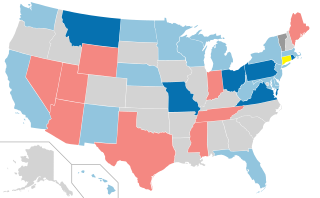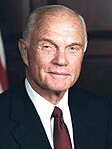The Democratic Senatorial Campaign Committee (DSCC) is the Democratic Hill committee for the United States Senate. Its purpose is to elect Democrats to the United States Senate. The DSCC's current Chair is Senator Gary Peters of Michigan, who succeeded Nevada's Catherine Cortez Masto after the 2020 Senate elections. DSCC's current executive director is Christie Roberts.

The Ohio Republican Party is the Ohio affiliate of the Republican Party. It was founded in Columbus, Ohio, in 1854.

The 1996 United States Senate elections were held on November 5, 1996, with the 33 seats of Class 2 contested in regular elections. Special elections were also held to fill vacancies. They coincided with the presidential election of the same year, in which Democrat Bill Clinton was re-elected president.

The 1992 United States Senate elections, held November 3, 1992, were elections for the United States Senate. The 34 seats of Class 3 were contested in regular elections, along with special elections to fill vacancies. They coincided with Bill Clinton's victory in the presidential election. This was the first time since 1956 that the balance of the Senate remained the same.

The 1980 United States Senate elections were held on November 4, coinciding with Ronald Reagan's victory in the presidential election. The 34 Senate seats of Class 3 were contested in regular elections. Reagan's large margin of victory over incumbent Jimmy Carter gave a huge boost to Republican Senate candidates, allowing them to flip 12 Democratic seats and win control of the chamber for the first time since the end of the 83rd Congress in January 1955. This was the first time since 1966 that any party successfully defended all their own seats.

The 2006 United States Senate elections were held on November 7, 2006, with all 33 Class 1 Senate seats being contested. The term of office for those elected in 2006 ran from January 3, 2007, to January 3, 2013. Before the election cycle, the Republican Party controlled 55 of the 100 Senate seats.

The 1970 United States Senate elections was an election for the United States Senate. It took place on November 3, with the 33 seats of Class 1 contested in regular elections. Special elections were also held to fill vacancies. These races occurred in the middle of Richard Nixon's first term as president. The Democrats lost a net of three seats, while the Republicans and the Conservative Party of New York picked up one net seat each, and former Democrat Harry F. Byrd Jr. was re-elected as an independent.

The 1968 United States Senate elections were elections for the United States Senate. Held on November 5, the 34 seats of Class 3 were contested in regular elections. They coincided with the presidential election of the same year. The Republicans picked up five net seats in the Senate. This saw Republicans win a Senate seat in Florida for the first time since Reconstruction.

The 1964 United States Senate elections were held on November 3. The 33 seats of Class 1 were contested in regular elections. Special elections were also held to fill vacancies. They coincided with the election of President Lyndon B. Johnson by an overwhelming majority, to a full term. His Democratic Party picked up a net two seats from the Republicans. As of 2023, this was the last time either party has had a two-thirds majority in the Senate, which allowed the Senate Democrats to override a veto, propose constitutional amendments, or convict and expel certain officials without any votes from Senate Republicans. However, internal divisions would have prevented the Democrats from having done so. The Senate election cycle coincided with Democratic gains in the House in the same year.

The 2006 United States Senate election in Ohio was held November 7, 2006. Incumbent Republican Mike DeWine ran for re-election, but was defeated by Democratic congressman Sherrod Brown. As of 2024, this is the most recent time a Democratic Senate candidate in Ohio won a race by double digits.

The 2008 United States elections were held on Tuesday, November 4, 2008, during the war on terror and the onset of the Great Recession. It was considered a Democratic wave election, with Democratic Senator Barack Obama of Illinois defeating Senator John McCain of Arizona by a wide margin, and the Democrats bolstering their majorities in both chambers of Congress, thereby marking the first time since 1992 in which the Democrats won Congress and the presidency in one election.

The 2004 United States elections were held on Tuesday, November 2, 2004, during the early years of the war on terror and after the 2003 invasion of Iraq. Republican President George W. Bush won re-election and Republicans retained control of Congress.

The 2004 United States Senate election in Ohio took place on November 2, 2004. It was concurrent with elections to the United States House of Representatives and the presidential election. Incumbent Republican U.S. Senator George Voinovich won re-election to a second term with the highest raw vote total in Ohio history. This remains the last Ohio statewide election to date in which a candidate won every county in the state. This was the first election since 1950 that an incumbent Republican Senator from Ohio was re-elected or won re-election for this seat.

The 1980 United States Senate election in Georgia was held on November 4, 1980. Incumbent Democratic U.S. Senator and former Governor of Georgia Herman Talmadge ran for reelection to a fifth term, but lost narrowly to Mack Mattingly, Chairman of the Georgia Republican Party.

The 1994 United States Senate election in Ohio took place on November 8, 1994. Incumbent Democratic U.S Senator Howard Metzenbaum decided to retire after 19 years in the United States Senate. Republican nominee Mike DeWine won the open seat against Democratic nominee Joel Hyatt, Metzenbaum's son-in-law. Independent candidate, conservative anti-abortion activist Joe Slovenec performed very well, getting over 7% of the vote. DeWine was the first Republican to win a U.S. Senate race in Ohio since 1970.

The 1980 United States Senate election in Ohio took place on November 4, 1980. It was concurrent with elections to the United States House of Representatives. Incumbent Democratic U.S. Senator John Glenn won re-election to a second term in a landslide with nearly 69% of the vote, coinciding with Ronald Reagan's substantial win in the state during the presidential election. Glenn carried all but one of the state's 88 counties, only losing Paulding County.

United States gubernatorial elections were held on November 8, 2022, in 36 states and three territories. As most governors serve four-year terms, the last regular gubernatorial elections for all but two of the seats took place in the 2018 U.S. gubernatorial elections. The gubernatorial elections took place concurrently with several other federal, state, and local elections, as part of the 2022 midterm elections.

The 2024 United States Senate election in Ohio will be held on November 5, 2024, to elect a member of the United States Senate to represent the state of Ohio. Democratic incumbent Sherrod Brown is seeking a fourth term. He is being challenged by Republican businessman Bernie Moreno. Primary elections took place on March 19, 2024.

The 2022 Ohio gubernatorial election was held on November 8, 2022, to elect the governor of Ohio. Incumbent Republican governor Mike DeWine won re-election to a second term in a landslide, defeating Democratic nominee Nan Whaley, the former mayor of Dayton, with 62.4% of the vote. DeWine's 25-point victory marked the continuation of a trend in which every incumbent Republican governor of Ohio since 1994 has won re-election by a double-digit margin.

The 2022 Ohio general elections took place on November 8, 2022, throughout the US state of Ohio.























